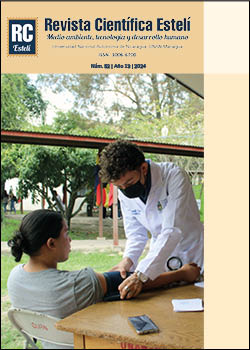Management of the English Language teaching and learning process at Bluefields Indian & Caribbean University, Nicaragua
DOI:
https://doi.org/10.5377/esteli.v13i52.19982Keywords:
Educational management, teaching and student perspectives, symbolic interactionism, academic performanceAbstract
The study analyzes the management of the teaching-learning process of the English language in students of the Faculty of Economic and Administrative Sciences of the Bluefields Indian & Caribbean University (BICU). With an observational, qualitative-quantitative, descriptive, and cross-sectional approach, the research included semi-structured interviews with teachers and students, in addition to a survey applied to 32 students. Based on Herbert Blumer’s Symbolic Interactionism, the findings reveal that, although teachers demonstrate the ability and willingness to implement learning strategies, there are areas for improvement related to student motivation and the use of educational technologies. A significant proportion of students perceive deficiencies in key skills such as reading, comprehension, pronunciation, and writing. The correlation between teachers’ perceptions and student progress suggests that class structure has a significant influence on learning. In terms of academic performance, most students are at a regular level, although there are opportunities to strengthen language skills, adapt methodologies and improve educational infrastructure. In conclusion, it is recommended to design an interdisciplinary and contextualized management model for the English department at BICU. This model should focus on curriculum, programs, linkage and implementation of innovative and motivating strategies, along with the effective use of ICTs. Continuous teacher training is essential to meet today’s educational challenges. In addition, it is suggested to implement internships that guarantee an adequate renewal of the faculty.
Downloads
References
Blumer, H. (1969). “Symbolic Interactionism: Perspective and Method”. University of California Press.
Bolio Ortiz, J. (2014). Vista de interaccionismo simbólico: modelo metodologico. Revista Juridica unam.mx/. Retrieved from https://www.juridicas.unam.mx/
Cantoni Rabolini, N. M. (2009). Técnicas de muestreo y determinación del tamaño de la muestra en investigación cuantitativa. Revista Argentina de Humanidades y Ciencias Sociales, 7, nº 2 (2009). Retrieved from http://www.sai.com.ar/metodologia/rahycs/rahycs_v7_n2_06.htm
Cazau, P. (1999). Experiencia en planificación didactica. PDFCOFFEE, 1. Retrieved from https://pdfcoffee.com/experiencias-en-planificacion-didactica-pdf-free.html
CNN en Español. (2022, Noviembre 17). cnnespanol.cnn.com. Retrieved from cnnespanol.cnn.com: https://cnnespanol.cnn.com/2022/11/17/argentina
Consejo de Europa (2001). Marco común europeo de referencia para las lenguas: aprendizaje, enseñanza y evaluación. . Instituto Cervantes. Retrieved from https://cvc.cervantes.es/obref/marco/
Consejo Nacional de Evaluación y Acreditación (CNEA). (2020, Noviembre 30). cnea.edu.ni. Retrieved from cnea.edu.ni: https://www.cnea.edu.ni › sites › default › files
Fagot, A. (2022, Mayo 09) Percepción del funcionamiento del departamento de Ingles. (W. Fedrick, Interviewer) Bluefields, Región Autónoma Costa Caribe Sur.
González Halcones, M. Á., & Pérez González, N. (2004). La evaluación del Proceso de Enseñanza-Aprendizaje. 5. Retrieved from https://ruidera.uclm.es/server/api/core/bitstreams/07620d89-c0f3-4618-8696-d6a11734f21a/content
Hernández, Fernández, & Baptista (2014). Metodología de la investigación. México: McGraw-Hill. Retrieved from (http://asistidametodologia001edu.lacoctelera.net/post/2010/04/19/paradigmas-o-tendencias-investigacion-educativa.
Marco Común Europeo de Referencia. (2002). https://cvc.cervantes.es/ensenanza/biblioteca_ele/marco/cvc_mer.pdf. (I. C. Español., Producer) doi:84-667-1618-1 84-690-1675-X
Moreno, R., & Galván, G. (2020). Realidad aumentada realidad virtual para la creación de escenarios de aprendizaje de la lengua inglesa desde un enfoque comunicativo. Retrieved from http://ddd.uab.cat/record/226872
Oxford, R. (2000). “Good Language Learners”An Update. ERIC.
Requesens, E., & Diaz, G. (2009). Una revisión de los modelos didácticos y su relevancia en la enseñanza de la ecologia. 1. Obtenido de https://www.sai.com.ar/ metodologia/rahycs/rahycs_v7_n1_03.htm
Richards, J. C., & Rodgers, T. S. (1986). Approaches and methods in language teaching. Cambridge University Press.
Ríos, D. (2022, junio 17). Percepción sobre el departamento de inglés. (W. Fedrick, Interviewer)
Rodríguez Ruiz, M., García, E., & Meras Garcias. (2005). Las estrategias de aprendizaje y sus particularidades en lenguas extranjeras. Ibeoroamericana de la Educación., 5. doi:1681-5653
Ruíz de Miguel, C. (2001). Factores familiares vinculados al bajo rendimiento. Revista Complutense de Educación XII,, XII, 81-113. doi:1130-2496
Zeledón Zeledón, j. j., Rivera Mairena, B. Y., & Tercero González, Y. E. (2021). Challenges faced by an English teacher in multi-grade schools. Repositorio Institucional UNAN-Managua. Retrieved from https://repositorio.unan.edu.ni/
Downloads
Published
Issue
Section
License
Copyright (c) 2025 Revista Científica Estelí

This work is licensed under a Creative Commons Attribution-NonCommercial-ShareAlike 4.0 International License.

